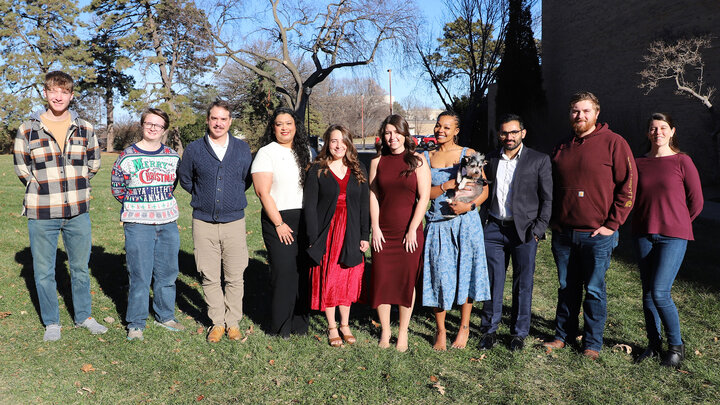Milos Zaric, a doctoral student in agronomy, placed second in the Agronomic Crops Poster Presentations at the Western Society of Weed Science Annual Meeting March 7-10 in Newport Beach, California.
Zaric is specializing in weed science and is advised by Sam Wortman, associate professor of agronomy and horticulture.
His research poster was titled “Industrial Hemp Biomass Negatively Affected by Herbicide Drift from Corn and Soybean Herbicides.” His poster explained how after the 2018 Farm Bill, industrial hemp was recognized as a crop legal to grow. Allowance of this crop to be grown for various purposes such as fiber, grain, hemp oil, cannabinoids, etc. resulted in increased industrial hemp acreage cultivated throughout the United States.
However, implementing industrial hemp fields in areas with adjacent soybean and corn fields raised questions regarding the crop susceptibility to off-target movement of commonly applied herbicides in these crops. Therefore, the main objective of his study was to examine the sensitivity of industrial hemp to high TP95015EVS (TP) and relatively low AI95015EVS (AI) off-target movement of various herbicides registered for use in corn and soybean.
TP refers to a flat spray tip or conventional flat fan nozzle and AI refers to an Air Induction or Air Inclusion type of nozzle.
As expected, nozzle design influenced herbicide drift, where applications with conventional TP and air inclusion AI nozzles had 5% of the spray deposits reaching 5.9 and 2.0 m downwind, respectively. Overall, the greatest sensitivity of industrial hemp was observed for glyphosate, glufosinate, and mesotrione spray drift, with plants having 50% biomass reduction for TP at 19.3, 8.7, 9.3 m while for AI at 4.1, 4.0, and 2.9 m downwind, respectively. In addition, results suggest industrial hemp was more sensitive to dicamba than 2,4-D (Group 4 Mode of Action herbicides). Therefore, establishing industrial hemp fields adjacent to herbicide-tolerant crops such as corn and soybean in the High Plains region of the United States is at high risk.
The results of this study can be used to expand current knowledge and recommend the employment of additional drift-mitigation techniques and buffer zones to avoid economic losses.
“It was a pleasure to represent the agronomy and horticulture department and Pesticide Application Technology Lab at the 75th WSWS Annual Meeting,” Zaric said. “It was great to meet many new people from the Western part of the U.S. and hear about united efforts to make more diverse integrated pest management.”
The meeting included poster session presentations; general sessions, and presentations on the future of teaching, research, and extension in the West; a symposium on New Technology for Physical Weed Control; and presentations on Weeds of Agronomic Crops and Weeds of Range, Forest, and Natural Areas.
Student and member presentations topics included temperature effects on metabolic resistance, chemical control of weedy rice, seedbank management strategies, management challenges for garlic mustard, remote sensing of leafy spurge, and downy brome and Palmer amaranth management.




